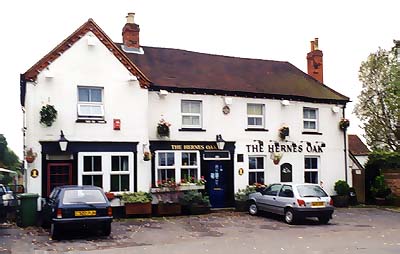
RBH Home
Maps & Travels
Articles
Legends
Towns & Villages
Castles & Houses
Churches
Biographies
Gentry
Family History
Odds & Ends
Mail David
Beware the Ghostly Hunt
Places to Go
 The tree on which Herne hanged himself has
always been known as “Herne’s Oak”. It used to stand in the Home
Park in Windsor, almost at its centre. In the eighteenth century it ceased
to bud and, sadly, in 1796, it was eventually pulled down. King George III
had given the order to remove it along with many other dead trees in the
Park; but, always afterward, he regretted his actions and during his
periods of madness would claim that it was still standing. Perhaps, like
other locals, he had seen the tree’s ghostly shape reappear where it
used to stand. In 1906, after years of confusion over the site of the oak,
Edward VII had a replacement planted where Herne’s original had once
stood. It can still be seen complete with commemorative plaque, but is,
understandably, out of reach to the general public. The most easily accessible
memorial to Herne in the old area of Windsor Forest today is the 'Herne's
Oak' in Cranbourne: a public house!
The tree on which Herne hanged himself has
always been known as “Herne’s Oak”. It used to stand in the Home
Park in Windsor, almost at its centre. In the eighteenth century it ceased
to bud and, sadly, in 1796, it was eventually pulled down. King George III
had given the order to remove it along with many other dead trees in the
Park; but, always afterward, he regretted his actions and during his
periods of madness would claim that it was still standing. Perhaps, like
other locals, he had seen the tree’s ghostly shape reappear where it
used to stand. In 1906, after years of confusion over the site of the oak,
Edward VII had a replacement planted where Herne’s original had once
stood. It can still be seen complete with commemorative plaque, but is,
understandably, out of reach to the general public. The most easily accessible
memorial to Herne in the old area of Windsor Forest today is the 'Herne's
Oak' in Cranbourne: a public house!
Sadly, the elm tree which marked the centre of Windsor Forest fell victim to the dreaded Dutch Elm Disease of the seventies, and so no longer graces the Berkshire skyline. Its huge stump can still be seen, however, standing beside the “Stag and Hounds” at the junction of Forest Road (B3034) and Tilehurst Lane in Binfield.
Cernunnos’ possible temple site at St. Leonard’s (Clewer) is where the later hermitage once stood. This disappeared many centuries ago, but the spot is still marked by the great house in St. Leonard’s Park, now Legoland off the B3022. His possible sacred grove, Robin Hood’s Arbour, sits in the middle of what little is left of Maidenhead Thicket on the western side of the town after which it is named. Heading out to Knowl Hill along the old Bath Road (A4), turn north towards Marlow at the roundabout junction with the A423(M). The Thicket is the wooded area to your left. The track leading to the arbour is not far along the road and there is plenty of parking at the entrance. A short walk will bring you to a wooded grove, again on the left. It is easily recognised, for a National Trust sign explains the site’s importance.
The Cernunnos altar from Notre Dame can be seen in the Musee de Cluny in Paris. The Gundestrup Bowl is in the National Museum of Denmark in Copenhagen.
